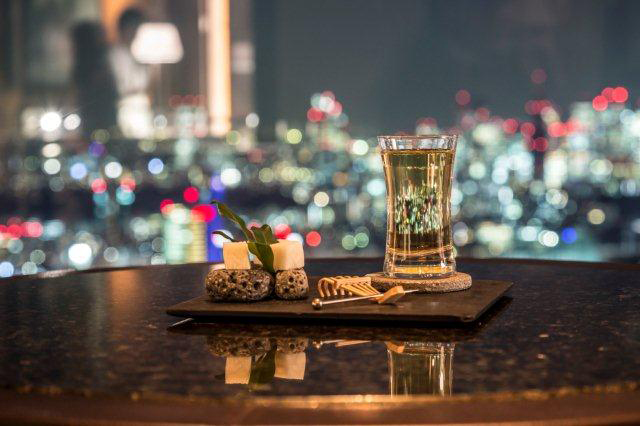The unsung hero of traditional Japanese cuisine is mirin, a deliciously sweet liquor made from sticky rice. Mirin is an essential cooking ingredient, used to balance the salty sharpness of soy sauce and to add luster to glazes. But prior to becoming a common fixture in the kitchen, the sugary beverage was prized as a luxurious tipple during the Edo Period (1603-1868), when it was imbibed at festivals and drunk as a health tonic. The drink grew in popularity as brewing techniques advanced in the 1800s, but was eventually eclipsed by sake — and later beer — as Japan's alcohol of choice.
These days, mirin rarely makes it onto the drinks list in Japan. Although I have encountered it a couple of times at sake-specialty bars and restaurants — usually paired with dessert courses — I had never tried it in a cocktail until last week, when I tasted The Bar, the new signature drink at The Ritz-Carlton, Tokyo's beautifully refurbished Lobby Lounge & Bar. Invented by barman Kentaro Wada to match The Ritz's contemporary East-meets-West decor, the Bar is a smooth blend of Tio Pepe sherry, Saijo Shiro-mirin from Baba Honten in Chiba Prefecture and three kinds of bitters infused with yuzu (Japanese citrus), shiso (perilla) and yomogi (Japanese mugwort). Wada based his recipe on the Bamboo, which was created by Louis Eppinger, a pioneering bartender in Japan and the German manager of the Grand Hotel in Yokohama toward the end of the 19th century. The classic Bamboo calls for dry sherry, dry vermouth and orange bitters, but Wada opts for Japanese flavors to "bring in more of the local culture" and shed light on the "craftsmanship of Japanese spirits," he says.
The mirin he uses has been handcrafted in the same way it was during the Edo Period. Most of the varieties used for cooking that are typically sold at supermarkets are mass-manufactured products low in alcohol, made with inexpensive base spirits and flavored with sugar and other additives. True mirin — called hon-mirin — contains around 40 percent to 50 percent residual sugar and 14 percent alcohol. Traditional producers start by making shōchū liquor, which is distilled from an alcoholic mash of water, rice and kōji (the fermentation catalyst used in sake, miso and soy sauce). Shōchū forms the base of a second mash, to which steamed glutinous rice is added. The second mash is left to ferment for up to three months before being pressed and left to mature in tanks.



